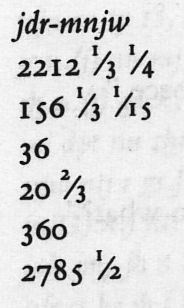James P. Allen has a fine section on numbers and things mathematical in his book:
Allen, James P. 2000, 2001. Middle Egyptian: an introduction to the Language and Culture of Hieroglyphs. Cambridge: Cambridge University Press.
including a section on fractions. At the end of such chapters are ‘exercises’, and exercising they certainly are for your amateur researcher. Here is page 107, which I hope he will not mind too much my including here.
Fig. 1 Page 107 from Allen’2 Middle Egyptian
I am interested in the item near the bottom, which Allen explains has been transcribed from a hieratic account. I refer to the table in half a dozen columns and a similar number of rows.
Fig. 2 JS’s attempt at summarising the information from Fig. 1
|
|
|
Fig. 3: Fig. 1, column 1 detail, with Allen’s answer from p. 477.
===========================================================
The following table explains the first line in the 'answers' in Fig. 3: jdr-mnjw.
"jdr"
|
ider =
|
"herd"
|
herd :
|
Allen [107:15.1]
|
<reed hand mouth bowl: straw>
|
|
"mnỉw"
|
meni-yu =
|
"herder's"
|
herd entity :
|
Allen [107:16.1]
|
<bender: swag ox>
|
Fig. 4 jdr-mnjw: ider meniyu
Allen says it means literally 'herders herd'. As the table shows, ider means 'herd', while meniyu <bender: swag ox>, means herd-entity, or someone or something connected with a herd — here using an alternative word for 'herd'. There are often quite different words for an idea such as this, probably reflecting nuances in meaning.
===========================================================
But back to the numerical analysis.
All this is fine, except that the arithmetic does not work.
The bottom line of the answer (2785 ½) is the sum of the entries above it.
So if we look at only the five fractions above to be added up:
1/3 + 1/4 + 1/3 + 1/15 + 2/3
and sum them, they should end up with a digit plus 1/2), according to the bottom line (2785 ½).
But they don’t. For if you convert the fractions to something with a common denominator, say 60, the above line for the five fractions becomes:
20/60 + 15/60 + 20/60 + 4/60 + 40/60
or, using 180 as the denominator:
60/180 + 75/180 + 60/180 + 12/180 + 120/180
(and it is necessary to use 180 because of fractions elsewhere in the big table)
This adds up to (20+15+20+4+40 =)
99/60 or 1 39/60
i.e. 297/180 or 1 117/180.
Should you be getting lost at this stage, remember that the fraction we are looking for at the end of the mathematical expression is 1/2 (as in 2785 ½), and 1/2 can be rendered:
30/60 (equivalent to 90/180)
— to be expected from Allen’s final line in his answer (2785 ½)
but not as:
99/60 or 1 39/60
i.e. 297/180 or (1 117/180)
—as indicated in the faint scribblings by your amateur researcher in his handwritten table above (see the bottom right-hand corner for this).
So it would seem that:
—or the original hieratic text was wrong;
—or the hieratic text was incorrectly copied for presentation in Allen’s book;
—or the Ancient Egyptians did not fuss over such mathematical niceties.
To enable you to check this yourself, here are some clues:
1000
|
100
|
10
|
1
|
1/2
|
1/4
|
fraction
|
bud
|
unwind
|
magnet
|
stroke
|
chisel: short
|
cross-X: line
|
mouth
|
|
|
|
|
|
|
|
<mouth>  denotes the start of a fraction, and such fractions always have 1 as the numerator, so <mouth magnet strokex2>
denotes the start of a fraction, and such fractions always have 1 as the numerator, so <mouth magnet strokex2>
 denotes the start of a fraction, and such fractions always have 1 as the numerator, so <mouth magnet strokex2>
denotes the start of a fraction, and such fractions always have 1 as the numerator, so <mouth magnet strokex2>
indicates 1/12 (although <mouth> would be placed above rather than in front of the subsidiary characters as shown here (see Allen’s page 107 above for many examples of such correct presentation).
CONCLUSION or inferences
Your amateur researcher (YAR) presumes that the intention of the original hieratic inscriber might have been to arrive at the answer shown by Allen, of 2785 ½. To achieve this result exactly, one or more of the entries above (Fig. 3, left column) would need to be altered to arrive at such a result, for example by omitting values equivalent to the superfluous 37/180 (as seen above as part of 1 117/180, so to reduce it to 1 90/180).
Your amateur research, too, hoped that by adding a stroke here and there in the first column of Fig. 3 above he could make it all work out neatly. But, try as he might, no such simple solution presented itself. So perhaps, without actually saying so, Allen has given us to understand that exactitude was not a characteristic in such AE calculations, and that
2785 117/180 was near enough to 2785 90/180
to be regarded as the 2785 ½,which he has given as the correct answer, and as the sequence of glyphs in the last line also claims:
But in the light of the absolute precision in columns 2-6 in the table (where in JS's handwritten table in Row e each has been ticked as correct), the anomalous result in column 1 is disappointing. Such clumsy mathematics could scarcely have underlaid the precision of the pyramids.
JEREMY STEELE
Saturday 12 April 2014
















No comments:
Post a Comment